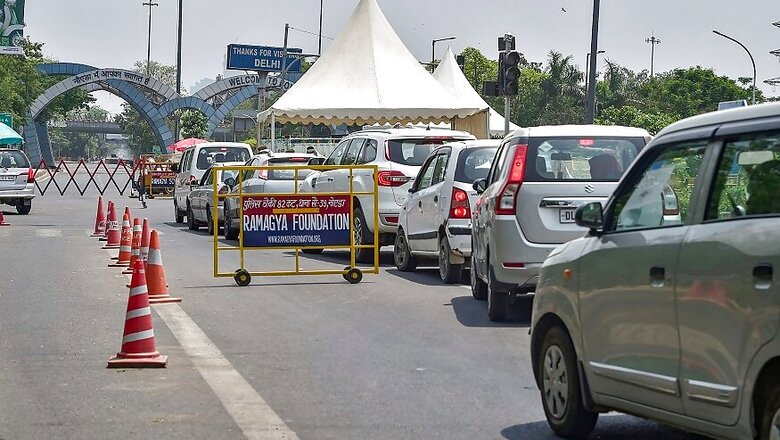
views
Exactly three years after the 1982 Asian Games transformed Delhi into a realty agent's dream come true, Parliament enacted the National Capital Region Planning Board Act with the concurrence of Haryana, Rajasthan and Uttar Pradesh. The NCR Planning Board was constituted. Delhi, we were told, would now be known better as NCR, a vast swathe of land with fluid borders and solid ambitions.
A few years later, the birdwatchers' favourite swamp called Okhla saw New Okhla Industrial Development Authority coming up next door—registered in 1976, but known today as Noida. And on the southern side of Delhi, Gurgaon (renamed Gurugram in 2016) became the manufacturing, and then IT backyard. Less glamorous 'emirates' like Faridabad of Haryana and Ghaziabad of Uttar Pradesh soon joined in, setting off a real estate explosion.
Can the National Capital be provincial?
The stereotyped middle-class Delhiite was no more the one living in Nizamuddin East or Greater Kailash 1. She lived in a palmy Noida apartment complex with pools and penthouses, drove to her start-up in Gurugram every day, and went pub-hopping on Friday evenings in South Delhi.
All this, taken for granted for about two decades now, was turned on its head by a virus, when Delhi chief minister Arvind Kejriwal first sealed borders with Haryana and Uttar Pradesh for a week, then sparked a debate on Delhi hospital beds for Delhiites only, adding that the half-state has been witnessing a spike in cases and wants to ensure best possible medical care for its residents alone. On Sunday, the CM announced that the borders would finally reopen on Monday.
But if health is a state subject, and that’s being reinforced with the capacity augmentation being left on the states, then are recent moves by the Kejriwal government steps in the right direction? Can a national capital be parochial and exclusionary even if it's about dealing with a pandemic?
Senior journalist Vir Sanghvi, a Mumbaikar, moved to Delhi in 1993 and says NCR was a conglomerate to him. He worked in Noida Film City, meetings would often take him to Gurugram, and he lived in Delhi. That’s how an average upwardly mobile NCR resident lived. “Kejriwal is implementing the idea of Bal Thackeray; it didn’t work in Mumbai," Sanghvi says. "It fails logic, as Delhi is the epicentre of Covid-19, how can he stop others from UP and Haryana to come? I always saw Delhi as an inclusive city. It breaks my heart to see it breaking apart.”
The Delhi government recently put out advertisements that those with mild symptoms have to either be in home-isolation or be admitted to Covid care centres if the former isn’t available. The administration says that it has enough ventilators, ICU beds and beds in its hospitals, and this exclusionary attempt is solely because it wants to ensure that those in Delhi get the best health treatment when the need arises.
Delhi’s top hospitals like AIIMS and Safdarjung don’t come under the Delhi government. The Aam Aadmi Party government says that there are beds in these hospitals which aren’t being released for it to ensure better medical facilities. The Delhi Corona app seeks to bridge the gap between the government’s arrangements for Covid-19 treatment and the availability of this information among the people. The app aims to provide updated information on the availability of beds and ventilators in various government and private hospitals. A web page has also been created to disseminate this data.
The fact is despite 15 AIIMS being sanctioned and 50 per cent of them being operational in several cities such as Patna, Raipur, Bhopal, etc, only AIIMS in the capital has top-notch facilities. While Delhi as we know it, governed by the Arvind Kejriwal-led AAP, has an area of 1,483 sq km and is officially named the National Capital Territory (NCT) of Delhi, the Central National Capital Region that includes immediate neighbourhoods such as Gurugram, Noida, Ghaziabad, etc, has an area approximating 3,483 sq km. The NCR otherwise spreads across 55,098 sq km. According to Census 2011, Delhi had a population of 16.8 million. The population of NCR, according to the same survey, was 46 million.
A Multi-dimensional Dilemma
The air pollution crisis faced by Delhi since 2017 symbolises how the city, its culture, lifestyle and air has been dependent on the acts of its neighbours. A blanket of smog in Delhi and the national capital territory has caused a diplomatic and international embarrassment with peaks in PM2.5 and PM10 levels. Delhi blamed it on factories in industrial hubs of neighbouring states of Haryana and Uttar Pradesh. These industrial hubs are largely in Ghaziabad in Uttar Pradesh and Faridabad in Haryana. These two cities constitute the NCR. That’s where the irony lies.
The government’s dilemma - how to protect when it doesn’t have administrative control over the entire capital region. So, it appears the NCR may well have been a non-starter and times of pandemic, pollution only make its problems bigger and more defined. “Sealing borders is very short-sighted; with millions living on one side and working on the other side, you cannot do this. The pandemic has led to dislocation and this sealing would lead to disruption and distrust,” says Sohail Hashmi, seen as Delhi’s heritage keeper.
Delhi, unlike other metropolitan cities, didn’t have the space to grow. Hence, it created suburbs: Gurugram in Haryana and Noida in Uttar Pradesh emerged. Chennai expanded into Tamil Nadu, Mumbai into Maharashtra, but Delhi’s expansion wasn’t within the same state.
To get a measure of the economic interdependence of the NCR, consider this: 2 million people travel into Delhi from Noida and Gurugram on a daily basis.
A large chunk of them happens to be migrant labourers. They reside in the neighbourhoods and work in Delhi and vice versa. For example, workers living in areas such as Kapashera often work just across the border in Gurugram’s Udyog Vihar. Similar conditions can be found all over the capital city.
“One of the points we had discussed in our meeting with the chief minister was that cross-border restrictions should be removed. They have been causing problems for our industries, as many exporters and their employees live in Delhi and are unable to come to Gurugram,” said Manoj Jain, member of the Gurugram Industrial Association.
The National Institute of Urban Affairs (NIUA) tasked with preparing the Master Plan for Delhi (MPD) 2041 has also notified that the capital city cannot be considered in isolation.
Sources in the body who wished to remain anonymous said, "There are a lot of recommendations from the previous master plan that remain unfulfilled because the NCR was not taken as one entity. The states may be different but the inter-connectivity and interdependence make it imperative that plans are made accordingly."
The Whims of the NCR conglomerate
Prepared by the National Capital Region Planning Board and notified in 2005, Regional Plan 2021 for the first time introduced NCR as a categorisation. The plan advocated that the opportunities presented by Central NCR should be maximised to enable it to compete effectively with the NCT of Delhi, offering comparable employment opportunities, economic activities and a comprehensive transport system.
The NCRPB is mandated to prepare a regional plan based on policies of land uses and infrastructure development in the entire NCR.
However, Covid-19 seems to have unstitched the conglomerate.
Even the Supreme Court on Thursday took a dim view of the unilateral decisions being taken by each state in the NCR on their whims, and said a uniform and consistent policy must be framed for interstate movement of people.
A bench headed by Justice Ashok Bhushan cited the bunch of petitions that highlighted the difficulties faced by commuters on the borders of Delhi, Uttar Pradesh and Haryana in the NCR, and said a consistent view was imperative.
The bench emphasised on 'one policy, one path and one portal' for allowing movement of people across borders in the NCR.
The old adage of an easygoing big-hearted Delhiite—'Dilli dil walon ki'— could well be an idea of the past. But as many old orders get broken and newer ideas take shape, will the idea of NCR of aspiration be leading to the new idea of disjointed existence and distrust in the pandemic world. Delhi could just end up being another 'shehar', not the one which the poet of Delhi envisaged as the 'soul of the world' or the 'chosen city'.


















Comments
0 comment